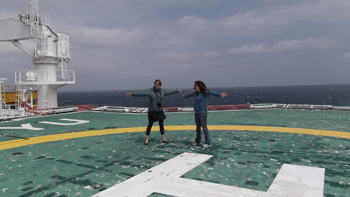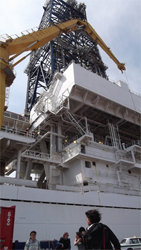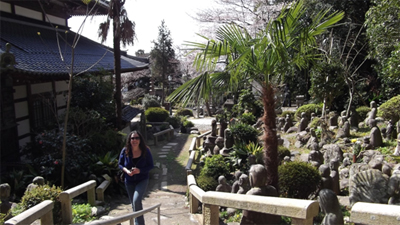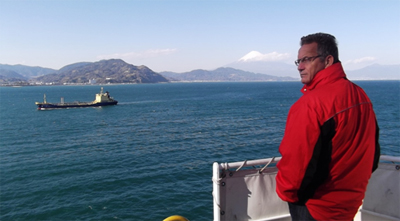

Short update from onboard ChikyuApril 13, 2012
Chikyu has been on site of our proposed boreholes for a few days now, but we haven’t yet begun drilling because various pieces of gear are playing up ? I don’t think this is atypical on drilling operations and am happy to bide my time and hope it all works out and we begin to core soon.
In the meantime, through variable weather, I’ve been learning my way around the ship, and learning about ship-board life.

The sun is reflected off a calmer ocean than today! Notice the slight curve in the horizon?
Photo by Nobu Eguchi.
One thing that keeps striking me is the apparent endlessness of the ocean we are sitting upon. I’ve been really enjoying standing on deck observing it. Every time I go up there, the sea state seems to have changed. Today it is particularly ‘interesting’ since there are two major conflicting sets of waves that are interacting. One large set coming from the east appear as ridges stretching across the whole ocean. A second set are less continuous, but when they intersect the large set in the right way, they form breaking waves and foaming masses of white water. When these hit the ship, we feel massive shudders, much like earthquake shaking. This just seems really odd in light of the two very large (Mw 8.2 and 8.6) strike slip earthquakes felt off Sumatra last night. Jim Mori (Co-chief scientist of this expedition) just gave an interesting presentation on those earthquakes, and we discussed whether similar events could be felt in this region some time after the mega-thrust earthquake.
There have been so many great scientific discussions onboard over the last few days, about a wide variety of research the Science Party members are presently engaged in that is relevant to understanding this particular subduction thrust fault. I think we are all intellectually primed and really ready to start coring as soon as we can!

Christie Rowe (Canada) and Monica Wolfson (USA) try to illustrate the extent of the endless ocean from the relative safety of the helicopter deck.


Chikyu sets sailApril 1, 2012
Most of the international scientists participating in the JFAST expedition (IODP Expedition 343) arrived in Japan on the 29th of March, 2012, and after a night in Tokyo, made their way on the bullet train to the port of Shimizu the next day. There, we boarded the Chikyu and were introduced to our accommodation, the onboard facilities, and lots of staff of the ship. The facilities are really impressive and I hope to learn a lot about the procedures that are in place to handle and log core, as well as about all the other forms of data that will be recovered (such as geophysical logs). IODP has been doing this sort of work for a long time, and I think there are a lot of good lessons I can learn that I can apply in the next phase of drilling for the Alpine Fault ? Deep Fault Drilling Project (DFDP) in New Zealand.

Scientists are dwarfed by the Chikyu’s drill derrick as they arrive and start to board.
In front is Francesca Remitti, from Italy.
The Chikyu stayed in port the next day, allowing some of us to explore the local area, and obtain last minute provisions for the next 54 days at sea. I managed to go for a last run on land this morning, through quaint Japanese streets and orange groves. I discovered a Buddist Zen Temple (Seikenji Temple) dating from 679AD, just up the hill that we went back to visit later. Something I was impressed by is that the locals sell the produce from their back gardens via ‘honesty box’ stalls outside their houses ? this is something we do in my home town in New Zealand as well!

Monica Wolfson (USA) explores the grounds of Seikenji Temple, Shimizu.
Now, its just after 3pm on the 1st of April and the Chikyu has finally set sail. Everyone went out on deck to watch as we pulled away from the port in breezy but sunny conditions. Mt. Fuji was spectacularly visible on the skyline to the north as we sailed away. We’re presently steaming our way out through the harbour mouth and will then start to sail northeast towards the proposed drilling sites. The boat is beginning to sway gently so maybe we’ll all find out how we get on with motion sickness now. We start our shifts tonight, and I am scheduled to work midnight to midday, so I will soon be headed off to bed for a few hours of sleep.

Jan Behrmann (Germany) looks pensively landward
as we steam out of port in the shadow of Mt. Fuji.

















